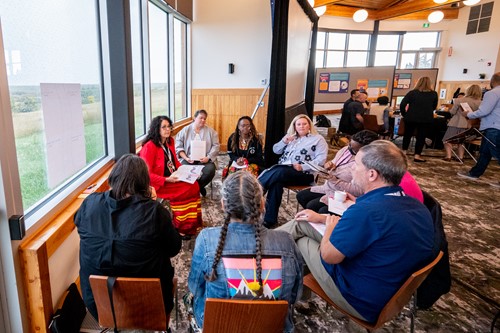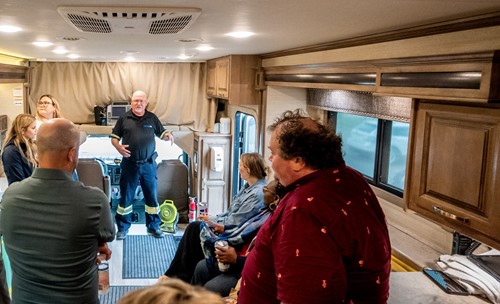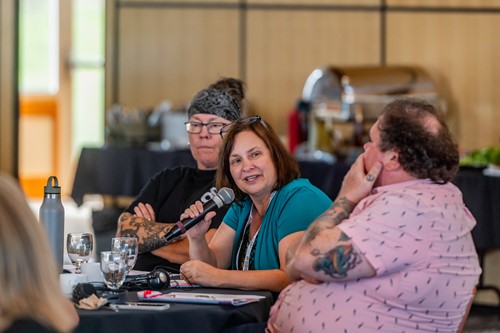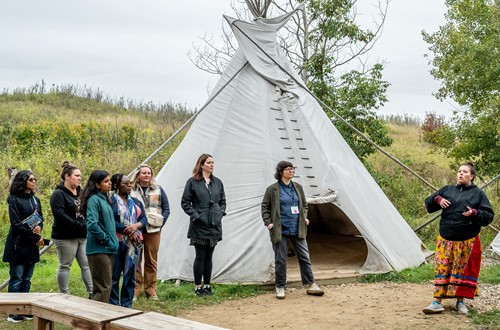Program overview :
“A benefit I was not expecting in joining the collaborative but have found incredibly valuable is the opportunity to connect with other teams across the country who are doing similar or related work. We are able to learn from their experiences and benefit from their collective wisdom to help move not only our project but also our broader palliative care services forward.”
- Umilla Stead, Regional Lead, Palliative Approach to Care, Vancouver Coastal Health
What is the Improving Equity in Access to Palliative Care collaborative?
Many current models of palliative care are not prepared to meet the needs of people who are vulnerably housed, staying in shelters or living in outdoor spaces. There are often barriers to diagnosis, treatment and support needs, which means that health conditions that could be preventable or treatable may become life threatening. This makes it difficult to access palliative care when it is needed most.
Improving Equity in Access to Palliative Care brings together diverse perspectives and experiences, including people with lived and living experiences to design, implement and evaluate initiatives that will improve access to equity-oriented palliative care. These initiatives ensure care is delivered in a timely way, reducing emergency department visits and hospital admissions and allowing to people to receive care with dignity in the environment of their choice.
How participating communities are improving equity in access to palliative care
There are 23 participating communities participating in the four-year pan-Canadian learning collaborative funded by Health Canada and led by Healthcare Excellence Canada and the Canadian Partnership Against Cancer (the Partnership).
Early impact of the collaborative shows:
- 83% of participating communities feel more prepared to provide an equity-oriented palliative approach to care
- In phase one of the program, communities held more than 40 training events including 20 sessions on cultural competency led by First Nations, Inuit and Métis coaches
Improving Equity in Access to Palliative Care supports progress towards the objectives of the Framework on Palliative Care in Canada and the federal Action Plan on Palliative Care, which highlight the importance of improving access to palliative care for underserved populations.
If you have questions about the Improving Equity in Access to Palliative Care collaborative, please contact IEAPC-AEASP@hec-esc.ca.
Featured content
Meeting people where they are at: Palliative Advocacy & Care Team (PACT)
In this blog, learn how Thunder Bay’s PACT is improving access to palliative care for people experiencing homelessness through equity-focused outreach, advocacy and lived-experience support.
Featured content
Meeting people where they are at: Palliative Advocacy & Care Team (PACT)
In this blog, learn how Thunder Bay’s PACT is improving access to palliative care for people experiencing homelessness through equity-focused outreach, advocacy and lived-experience support.
Participating communities
Learn more about the teams, their diverse projects and where they’re located.
Improving Equity in Access to Palliative Care in action

Team members and coaches participating in the Improving Equity in Access to Palliative Care collaborative participating in a land-based learning session facilitated by Wanuskewin staff.

Team members representing The Grey-Bruce Ontario Health Team / Brightshores Health System and Fort Erie Native Friendship Centre exchanging learnings about their initiatives at a program workshop.
 Dr. Holly Prince, one of the Improving Equity in Access to Palliative Care coaches, facilitating group discussions with team members representing Alberta Health Services, Champlain Hospice Palliative Care Program, Bruyère, Fort Erie Native Friendship Centre, Niginan Housing Ventures, and NL Health Services – Labrador-Grenfell Zone at a program workshop.
Dr. Holly Prince, one of the Improving Equity in Access to Palliative Care coaches, facilitating group discussions with team members representing Alberta Health Services, Champlain Hospice Palliative Care Program, Bruyère, Fort Erie Native Friendship Centre, Niginan Housing Ventures, and NL Health Services – Labrador-Grenfell Zone at a program workshop.
 Team members representing Huron Shores Family Health Team, NL Health Services – Eastern Rural/Urban Zones and Victoria Cool Aid Society learning about the Saskatoon Tribal Council Health Bus which is a collaborative initiative between Medavie Health Services, the Saskatoon Tribal Council and the Government of Saskatchewan serving seven First Nations communities.
Team members representing Huron Shores Family Health Team, NL Health Services – Eastern Rural/Urban Zones and Victoria Cool Aid Society learning about the Saskatoon Tribal Council Health Bus which is a collaborative initiative between Medavie Health Services, the Saskatoon Tribal Council and the Government of Saskatchewan serving seven First Nations communities.
 Dr. Kelli Stajduhar, one of the Improving Equity in Access to Palliative Care coaches, sharing reflections at a program workshop joined by team members representing Thunder Bay’s Palliative Advocacy and Care Team (PACT) and Victoria Cool Aid Society.
Dr. Kelli Stajduhar, one of the Improving Equity in Access to Palliative Care coaches, sharing reflections at a program workshop joined by team members representing Thunder Bay’s Palliative Advocacy and Care Team (PACT) and Victoria Cool Aid Society.
 Team members and coaches participating in the Improving Equity in Access to Palliative Care collaborative participating in a guided walk facilitated by Wanuskewin staff.
Team members and coaches participating in the Improving Equity in Access to Palliative Care collaborative participating in a guided walk facilitated by Wanuskewin staff.
What participating communities are saying
“As a group we saw human rights, dignity and equity not being upheld and we tried to make a difference. And we did.”
“As a group we saw human rights, dignity and equity not being upheld and we tried to make a difference. And we did.”
“It takes a village to do equity work. This is my village.”
“It takes a village to do equity work. This is my village.”
“This collaborative is proof that the work can be done.”
“This collaborative is proof that the work can be done.”
“This is a group that has shared passion and purpose that is bigger than themselves. That is worth sharing.”
“This is a group that has shared passion and purpose that is bigger than themselves. That is worth sharing.”
“You have to slow down to get to where you want to go.”
“You have to slow down to get to where you want to go.”
Related Resources
{{currentEntry.friendlyTitle.length > 0 ? currentEntry.friendlyTitle : currentEntry.title}}
- {{param_allText}}
- {{decodeURI(filterType.title).replaceAll('+', ' ').replaceAll('%26', '&')}}
- {{param_allText}}
- {{decodeURI(filterType.title).replaceAll('+', ' ').replaceAll('%26', '&')}}
- {{param_allText}}
- {{decodeURI(filterType.title).replaceAll('+', ' ').replaceAll('%26', '&')}}
